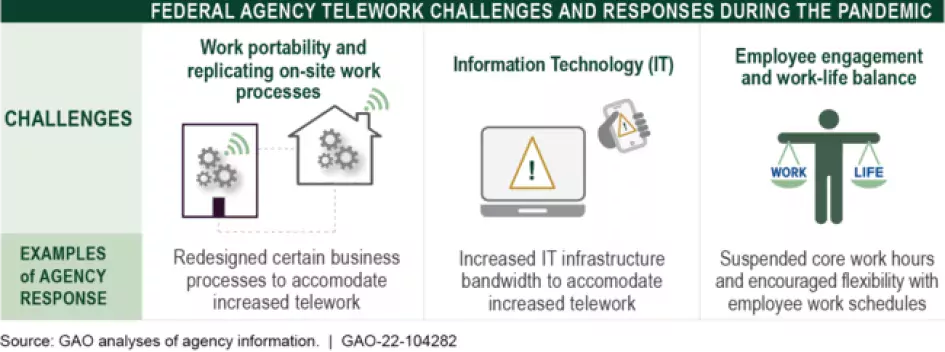Federal Employees Teleworked More During COVID-19, But What Does the Future of Work Look Like?
When COVID-19 struck, many offices and businesses allowed their employees to work from home, or telework. The federal government, one of the largest single employers in the U.S., similarly moved to telework. This has allowed federal agencies and employees to continue their missions, maintain operations, and serve the public during this crisis. But what do we know about the challenges telework has presented to federal agencies and staff, and what could the future of telework activities look like?
Today’s WatchBlog post looks at our latest report on federal telework during COVID-19.
Image

What has federal employee telework looked like so far?
In our new report, we collected data from 24 major federal agencies to see how telework had changed during COVID-19. All 24 agencies reported a substantial increase in the use of telework. For example, some federal agencies reported that during the pandemic, telework hours comprised more than 80% of total work time. Full-time telework increased during the pandemic as well—14 of the agencies we spoke with had at least a quarter of teleworking employees doing so full time.
Agencies faced some challenges transitioning to telework
Agencies initially experienced challenges replicating the office environment. For example, we were told that things like hiring, conducting security checks, and mail delivery were all more challenging in an enhanced telework environment. Agencies also faced initial challenges including IT equipment shortages, lack of training, and limited network capacity. To find out more about the IT challenges federal agencies faced, check out our podcast with GAO’s Jennifer Franks.
Several agencies also reported that they faced challenges with employees who experienced decreased engagement or employees who found it difficult to maintain a healthy work-life balance during the COVID-19 pandemic.
Image

Agencies are considering future workplace changes related to telework and remote work
Agencies told us they are considering future workforce changes that include (1) instituting more flexible work arrangements, (2) establishing or updating remote work policies, and (3) reassessing facilities and infrastructure. Related actions may include increasing the number of telework days for eligible employees and assessing agencies’ physical office space and workforce needs. For example, agencies are assessing how an increase in telework and remote work will affect facilities and infrastructure.
Better data on telework would help agencies prepare for future telework needs and use
Better and more reliable data on how telework was used during COVID-19 would help the federal government prepare for emergencies.
The Office of Personnel Management (OPM) collects data on federal telework and reports that information annually to Congress, but has made limited progress addressing longstanding data quality issues. In 2016, we made four recommendations to OPM related to improving the reliability of its federal payroll data system, including telework information. While OPM agreed with our recommendations and implemented one, it has not developed a plan to address the remaining three recommendations—consistently monitoring error reports, integrating payroll data into more of databases, and strengthening internal control activities.
Developing a plan to address these recommendations would better position OPM to improve its reporting of telework. It would also allow OPM to provide more accurate and useful information to Congress, and set the stage for a future that could involve more telework across the government. In our new report, we’ve also suggested that Congress consider requiring OPM to develop a plan, consistent with our recommendations, to improve its reporting of federal telework data.
To find out more about federal telework during COVID-19, check out our new report.
- Comments on GAO’s WatchBlog? Contact blog@gao.gov.





